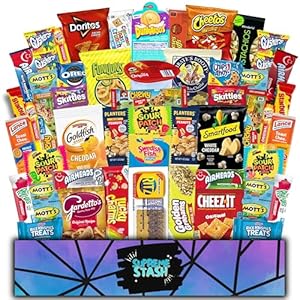
As a kid, I loved all things Disney. Unfortunately, I was born in a time when my options for Disney entertainment were more limited. On any normal week, I might be able to read a book (comic or children’s), listen to a Disney record, or if I was lucky catch The Wonderful World of Disney. It was the records that I listened to the most. I had this tank-like portable General Electric record player that I inherited from my sisters. I would sit on the floor and listen to the handful of Disney records I owned again and again. Perhaps most prized in my collection was one that had nothing to do with any existing Disney character or movie, Chilling, Thrilling Sounds of the Haunted House.
Horror made me nervous when I was young and the idea of listening to a record about anything haunted didn’t really appeal to me at first. But I found the Disney brand on it reassuring and intriguing. I am pretty sure that the first few times I gave it a listen I had to stop and start it repeatedly since it was making me nervous. Ultimately though, it won me over and became a standard record for me to play, especially as the Halloween season approached.
While many of us listened to in October, it’s easy to forget that Chilling, Thrilling Sounds of the Haunted House wasn’t made as a Halloween record. When it came out in 1964, Disneyland Records wasn’t thinking about trick-or-treating or costumes. They were just trying new things. Most of their albums were stories or songs from films, which is what I was familiar with, but this was something different. They already had a library full of sound effects from their movies, so someone likely figured they could turn those into something people might enjoy on their own. It was the prefect time to do it. Families at the time were buying record players and kids were experimenting with tape recorders, so it made sense to put out an album that was mostly sounds.
The first version was simple. One side had short narrated scenes and the second side was only sound effects. It didn’t tell you what to do with them, it just let you decide. Maybe you could use it for a play, a school event, or to scare your friends? The last one I actually tried to do with a basement haunted house that didn’t work out. Whatever you decided, the record was more of a tool than a story, and it still had that careful Disney tone that made it safe for kids, but maybe not just for younger kids. The back cover even says it’s for “older children, teenagers, and adults,” which was unusual for a Disney record. It’s like they were saying, this one’s not just for kids.
It also came out at a good time. The early sixties were full of light horror and monster fun. The Addams Family and The Munsters were on TV, and Disneyland was working on The Haunted Mansion. Monsters were part of the culture again, but in a friendlier way. This record fit right in the very year it came out already found itself being rightly associated with Halloween.
The album grew out of the huge sound library at Walt Disney Studios. The studio had been collecting effects since the late 1920s, so by the early sixties they had every kind of noise you could think of. Wind, thunder, chains, creaking doors, and all sorts of strange mechanical sounds. When the record division was looking for new ideas, someone clearly realized they already had a treasure chest sitting there. I like to picture some sound engineer in a back room threading through reels of old film and thinking, this could make a great record.
On the first side of the album, there’s narration mixed with effects. Laura Olsher reads short little scenes with titles like “The Very Long Fuse” and “The Unsafe Bridge.” They are not stories in the usual sense, just quick setups that hand things off to the sound effects. Then the second side drops the narration entirely. It’s just groups of effects you can use however you like. It plays more like a tool than a story album, which was probably the point. The idea was that kids or adults could make their own stories or haunted soundscapes with it.
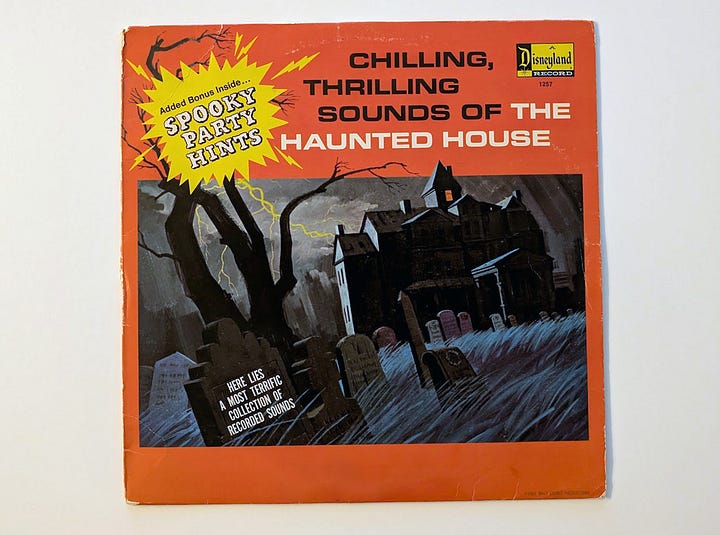
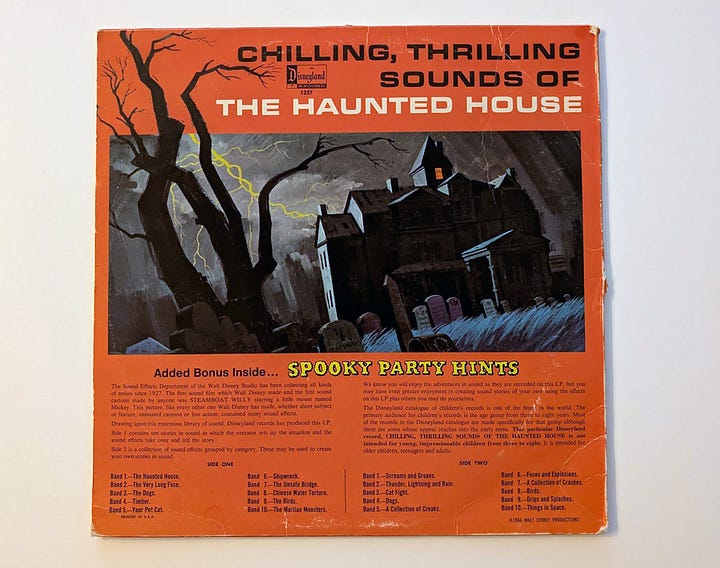
The cover was painted by Paul Wenzel, an artist who worked on Disney concept art during the sixties. His haunted house painting has that same eerie but tidy look that runs through the Haunted Mansion design work. It connects the record to the larger world Disney was building at the time, even if most people didn’t notice it then. The 1964 release did well enough that the company kept it in print for several years, and it built a quiet reputation as one of the more unusual titles in the catalog. It did well enough that a new version was released almost a decade later.
The 1973 version was a reissue of the same recordings. The sound mix and track lineup were unchanged. The difference was in how it was presented. The Disneyland Records logo had been redesigned, and the cover art and typography were adjusted to match that newer style. The reissue came at a time when the label was giving older titles fresh pressings, and this one was among them.
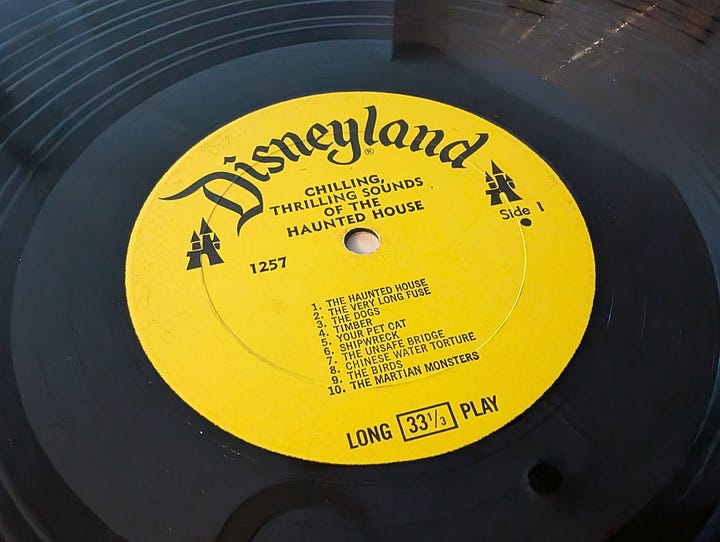

A fun thing you will find when looking inside is the fun art on the paper record sleeve. If you were listening to this as a kid, almost 100% of the time you were re-reading these and studying the art.
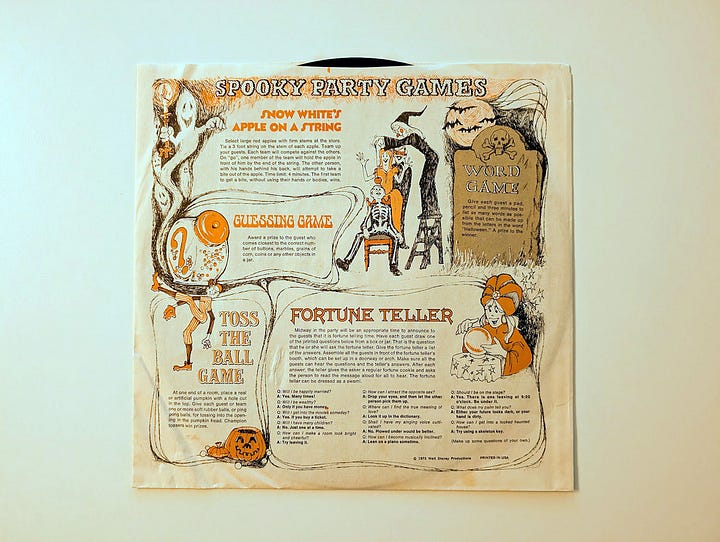

Some copies were marked as stereo, which makes them slightly different from the first mono release, but that is mostly a technical note rather than a creative one. It stayed a steady seller through the decade, often appearing in record stores alongside other general audience sound albums.
You might be thinking that this doesn’t sound at all like the version I have. That is because six years later, in 1979, a new edition hit the market. This one was a complete remake. It shared the same name but none of the same material. It featured a new narrator, new sound effects, and new recording sessions. The sound effects are noticeably cleaner and more theatrical. They appear to have been recorded on newer tape systems rather than reused from the earlier catalog. The editing and mix also reflect late seventies production methods, with sharper stereo separation and heavier use of reverb.
The cover was completely redone. They completely dropped the borders and it is completely dominated by a more vivid depiction of the mansion . This version was produced at a time when Disney’s record division was releasing more novelty and themed albums for home use. It was not a repress but a distinct production intended to refresh the brand and reach a newer audience.
So, when viewed together, the 1964 and 1973 records are two versions of the same product, the first establishing it and the second keeping it in circulation. The 1979 version is a separate project made to replace it rather than continue it. The change in tone and design between the two eras reflects shifts inside Disneyland Records itself more than any planned response to Halloween trends. These albums were both successful sellers. The 1964 album became a certified gold record by the RIAA on December 7, 1972. While the updated 1979 album was certified gold by the RIAA on April 11, 1988.
By the early 1980s, Disneyland Records (then also using the Vista label) released the Chilling, Thrilling Sounds of the Haunted House orange-cover version on cassette. It used the same 1979 master and track listing, with similar cover art resized for the plastic case. These tapes were sold through department stores and sometimes appeared in Halloween seasonal displays at Disneyland and Walt Disney World.
In the 1990s, Disney briefly revived the concept on compact disc, but not under the original name. Tracks from both the 1964 and 1979 versions appeared on CD compilations such as Halloween Songs & Sounds. These were mix-and-match collections that didn’t credit the original album directly, though the material came from it.
If you area collector, these albums, which were produced in great quantity are still very affordable. Which one you get will probably depend on the one you heard as a kid. If you haven’t heard it before, you will probably pick the one with the the cover that is most appealing. I grew up with the 1973 version, and so that is my favorite, but I see the charm of the original cover and find the changes they made in 1979 intriguing.
Looking back, it’s surprising how much personality that old record had for something without characters or songs. It was just a mix of voices, wind, creaking wood and other effects, yet it managed to feel like part of Disney’s world. I still think that’s what made it last. The company built so much around story and music that even when they tried something simpler, it stood out. Whichever version you happened to grow up with, it carried the same spirit. It was Disney experimenting, having fun with sound, and giving kids something they could imagine with. That’s probably why so many of us never stopped listening to it.
Trending Products


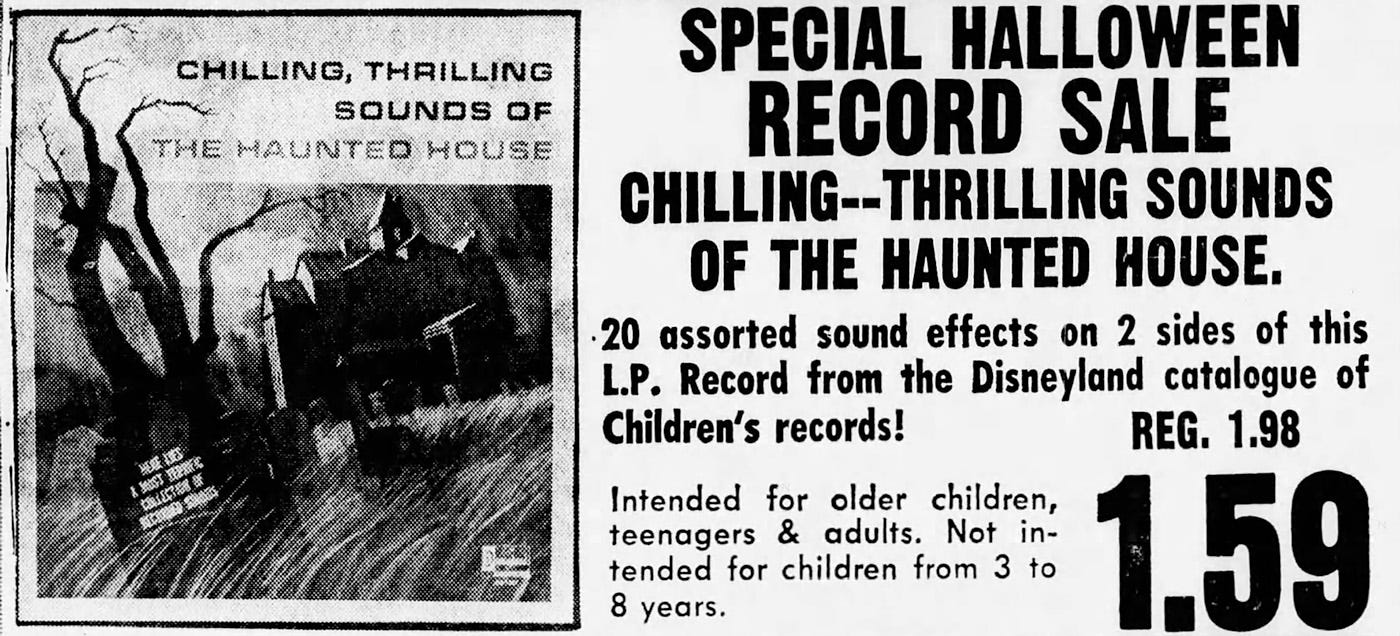
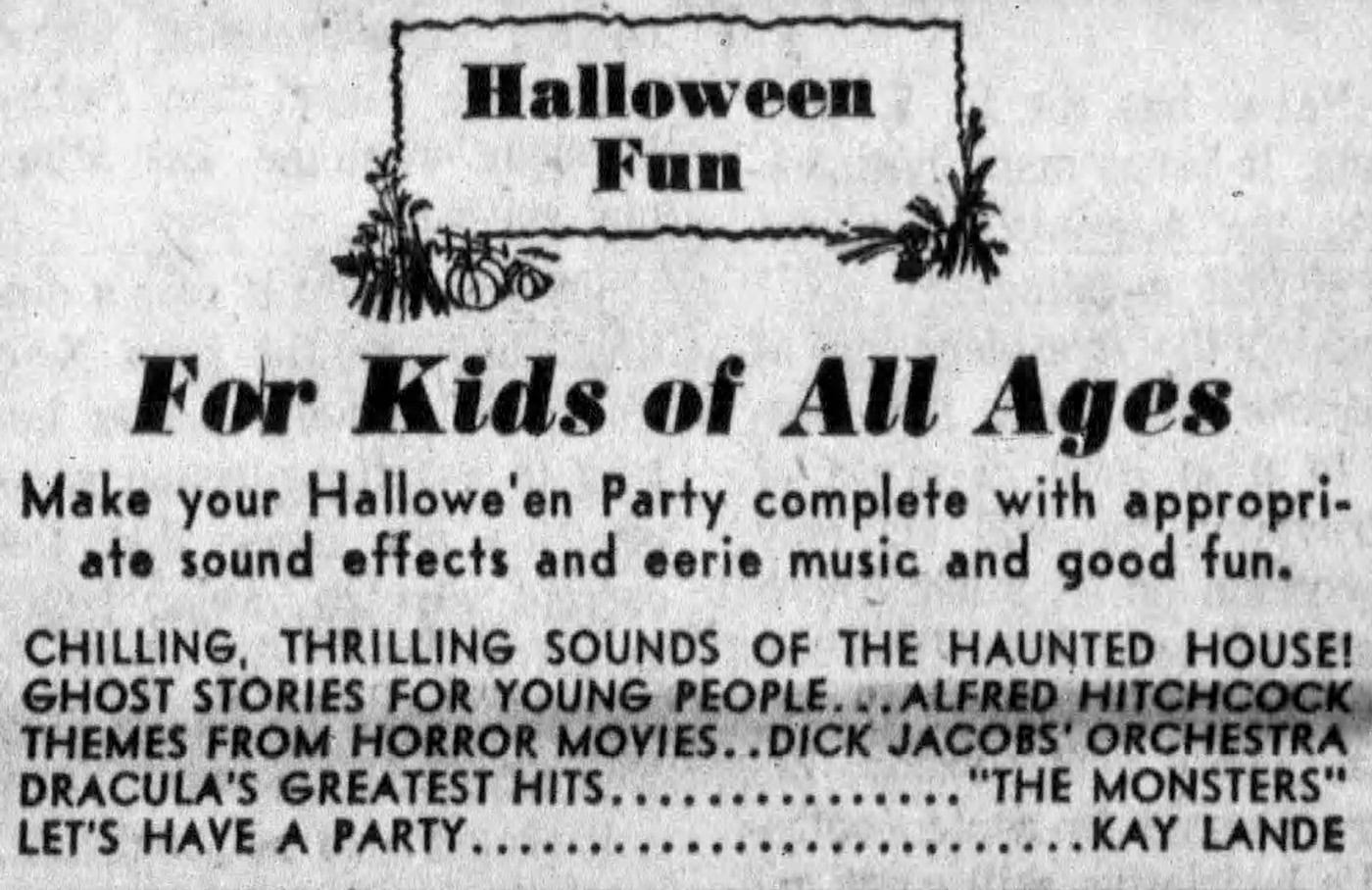
![NOW Country Classics: 90âs Dance Party[Lemon & Spring Green 2 LP]](https://m.media-amazon.com/images/I/61hVquUofcL._SL500_._SS300_.jpg)


